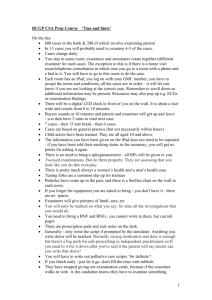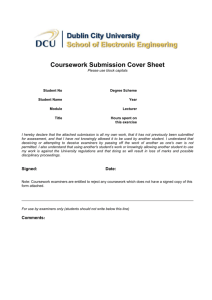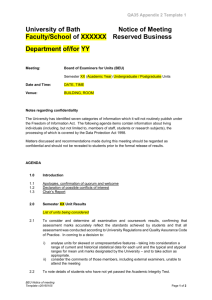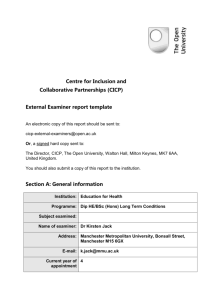approaching the written MRCGP exam
advertisement
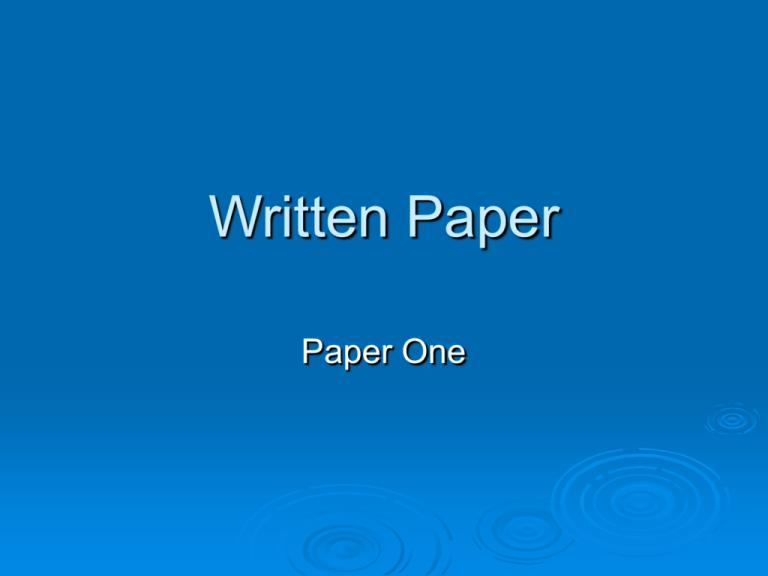
Written Paper Paper One Plan for seminar Format Content Different types exam questions – tips for each Implications for revision ‘Skeletons’ Examiners’ comments Resource Number One http://www.rcgp.org.uk past papers examiners comments regulations syllabus FORMAT Written Paper Format 3 hrs (+additional time for source material- usually around 30 mins) Examiner marked Answers legible, concise and short notes encouraged 12 questions (or more) ~15 mins per question including reading through Written Paper Format Combined question and answer booklet May use reverse side Implications Repetition Candidate number Answer all questions Written Paper Format Four question types test of general practice literature knowledge (CRQ) test of evaluation of written material (CRQ) test of ability to integrate and apply theoretical knowledge and professional values (MEQ) new formats CONTENT Major Themes of Written Paper Are: consultation-based problem-solving, informed decision-making and clinical management consultation and communication skills evidence-based practice in the treatment and prevention of disease Major Themes of Written Paper cont’d: critical appraisal challenges and dilemmas in practice values, sensitivity and empathy responsibilities to partners, other health professionals, and society Question Glossary (look them up) comment discuss factor implication issue manage process respond Test of literature knowledge Test of literature knowledge Majority of marks for demonstrating understanding of current views on a topic and the general evidence on which they are based Higher marks for quoting sources Higher marks still for including a brief critical appraisal references without understanding is not impressive May 2003 (HRT) It is worth pointing out to future candidates that when asking for evidence, examiners want to read of the knowledge gained from research evidence, rather than simply be given a reference to a trial. May 2003 (HRT) Where possible, identifying the precise source of evidence is worthwhile but of secondary value to actually knowing the evidence base of good current medical practice. For example:- B.P.H. Alpha blockers are better than placebo 5-alpha reductase inhibitors are better than placebo (understanding of current views on a topic and the general evidence on which they are based) Two systematic reviews for alpha blockers and one for 5-ARI Eur Urol 1999 and 2000 (Higher marks for quoting sources) High number of patients unaccounted for Considerable number of adverse effects (brief critical appraisal) Tests of literature knowledge examples Discuss the primary prevention of osteoporosis in general practice Tests of literature knowledge examples Evaluate the evidence for the effectiveness of drugs after discharge from hospital following an uncomplicated MI Tests of literature knowledge examples Summarise the available evidence for and against the use of antibiotics in otitis media Tests of literature knowledge examples Other recent questions drugs in the management of chronic asthma recognition of depression methods to help people stop smoking childbirth without consultant obstetricians current thinking on drugs for hypertension Test of literature knowledge REVISION revise common clinical problems and themes rather than consecutive journals Revision sources include BMJ / BJGP Clinical Evidence Bandolier, EBM, DTB, Effectiveness Matters RCGP occasional papers Guidelines of national status books! & seminal papers of yrs ago Revision Study group to share the load PBL during the consultation Areas of weakness Everyday general practice Flash cards? MSN MRCGP newsgroup http://groups.msn.com/MRCGPStudyGroup Evaluation of written material Each paper has had at least 3 of these type of questions Evaluation of written material analyse audit interpret the results - power of studies, pvalues, confidence intervals, NNT, odds ratio, sensitivity, specificity and predictive value no calculations required but you must understand what the terms mean Evaluation of written material apply results to a clinical scenario apply EBM approach to clinical scenario: question / search / appraisal / application critically appraise presented material, a clinical study, systematic review, guidelines Evaluation of written material Recognising the main issues raised. Commenting on study design. Discussing the implications and practical application of the results to general practice. Commenting on study design Commenting on Study Design How to read a paper Trisha Greenhalgh Cheap version – www.bmj.com Study design Does the paper address a question relevant to your practice? Where did the research take place and who are the authors? Do they have a vested interest? Study design What type of study and is it appropriate? How were subjects / controls selected? Were they randomised; if so, how? What were the outcome measures? Are they clinically relevant? Do the sample numbers appear to be appropriate? Study design - results Are all the subjects accounted for? How are the results presented? Is the statistical analysis present and appropriate? Study design- conclusions Are the conclusions reasonable in the light of the results? Do the authors address the limitations of the study? Are the results believable? Study design - overview Concurrence with other studies Concurrence with own experience Implications for me Study design - Checklists eBMJ editor’s checklist peer reviewer’s checklist statistician’s checklist qualitative research checklist drug points checklist economic evaluation Study design - Checklists http://www.rcgp.org.uk/rcgp/journal/referee/method.asp (qualitative research) http://www.rcgp.org.uk/journal/info/index.asp?menuid=71 (information for authors and readers) http://jama.ama-assn.org/ifora_current.dtl (RCT/Consort) Checklist - CONSORT statement CONsolidated Standard for Reporting Trials Chicago 1995 - published 1996 Randomised trial Use of a structured format Prospective hypothesis Prospective clinical objectives Planned sub-group analysis Study population with inclusion/exclusion criteria Planned interventions with timing Outcome measures with minimum important differences Sample size calculations Rationale/methodology for statistical analysis Prospectively designed stopping rules Unit of randomisation Method for allocation schedule Method of allocation concealment Separation of generator from executor of assignment Blinding Trial profile Estimated effect using a point estimate & precision measure Summary data in sufficient detail to replicate analysis Protocol deviations with reasons Interpretation of study findings with sources of bias General interpretation in light of general evidence Implications for practice Implications for practice Personal Patient Management Practice Policies Practice Organisation Practice Finances Work Of PHCT Members Referral Patterns Prescribing Contracts / Purchasing / Commissioning Consultants & Other Hospital Staff District Resources E.G.. Pathology Own Workload / Free Time Society As A Whole Problem-solving questions Around half of the paper – 6 questions Problem solving questions Complex situations or difficult patients - no right or wrong answers Answers will be evaluated for grasp of CONSTRUCTS Problem solving questions Read question carefully - answer what is asked Think broadly but realistically Avoid jargon and cliché - a good tip is to give examples (e.g. I.C.E. In M.S.) More marks for management of problem than factual knowledge THE EXAMINERS LOOK FOR...... A DIVERSITY OF APPROACH: Detailing a range of options and selecting the most appropriate, justifying selection with reference to the literature. Considering experiences and circumstances other than those personally experienced. Showing consideration for patients’ health beliefs and feelings, relatives, co-workers and self. Awareness of non-medical aspects of the problem. THE EXAMINERS LOOK FOR...... A DIVERSITY OF APPROACH: Detailing a range of options and selecting the most appropriate, justifying selection with reference to the literature. Considering experiences and circumstances other than those personally experienced. Showing consideration for patients’ health beliefs and feelings, relatives, co-workers and self. Awareness of non-medical aspects of the problem. THE EXAMINERS LOOK FOR...... A DIVERSITY OF APPROACH: Detailing a range of options and selecting the most appropriate, justifying selection with reference to the literature. Considering experiences and circumstances other than those personally experienced. Showing consideration for patients’ health beliefs and feelings, relatives, co-workers and self. Awareness of non-medical aspects of the problem. THE EXAMINERS LOOK FOR...... A DIVERSITY OF APPROACH: Detailing a range of options and selecting the most appropriate, justifying selection with reference to the literature. Considering experiences and circumstances other than those personally experienced. Showing consideration for patients’ health beliefs and feelings, relatives, co-workers and self. Awareness of non-medical aspects of the problem. PAPER ONE -problem solving questions Andrea Bachelor, 26, presents with a vaginal discharge. How do you arrive at a diagnosis? PAPER ONE -problem solving questions Norman Griffiths is an introspective 47 yr old man who suffers from long-standing fatigue. He tells you he has seen a television documentary suggesting that the mercury in amalgam dental fillings is toxic. He is wondering whether to have his fillings removed, and asks you for your views. Describe your thoughts IMPLICATIONS OF MARKING SCHEME Broad impressions count. Layout and presentation important. Relatively small differences in quality of content or presentation can make a real difference. Relatively easy to get bulk of marks up to pass level. Time spent vs marks gained 7 6 5 4 3 2 1 0 2 mins 4 mins 6 mins 8 mins 10 mins “Skeletons” Consultation Behaviour EXPLORE patient’s knowledge, ideas, concerns, expectations. EXPLAIN symptoms and signs, diagnosis and prognosis. CONSIDER treatment options. CONSIDER patient’s preference, involve patient in management plan. Consultation Behaviour Presenting Problems Continuing Problems Help Seeking Behaviour Opportunistic Health Promotion Treatment Options DO NOTHING Follow up at patient’s discretion or formally arranged. DO SOMETHING Discuss, negotiate, counsel, advise. Discuss other management options, obtain implied or informed consent. Prescribe drug and / or appliance. Arrange or carry out procedure. Follow up. Referral Options WITHIN PHCT SECONDARY CARE In patient, out patient, domiciliary visit, pathology, radiology, physiotherapy, day hospital, occupational therapy. Consider NHS / private, local / regional / national, PCGs. SOCIAL SERVICES Social worker, day centre, meals on wheels, home helps, part III accommodation, disabled parking badge, welfare benefits, citizen’s advice. Referral Options OTHER AGENCIES Self help groups, voluntary groups, local and national hospice movement, Marie Curie Foundation, WRVS. ALTERNATIVE THERAPIES In A Conflict Situation AGREE DISAGREE REFER NEGOTIATE COUNSEL EDUCATE Giving Bad News ANXIETY What are the the patient’s fears and worries? KNOWLEDGE How much does the patient know and understand already? EXPLANATION Diagnosis, prognosis, treatment and follow up (in terms the patient understands). SYMPATHY SUPPORT FOLLOW UP Dealing With Anger AVOID CONFRONTATION. FACILITATE DISCUSSION. VENTILATE FEELINGS. EXPLORE REASONS FOR ANGER. CONSIDER REFERRING OR INVESTIGATING. APOLOGISE (IF APPROPRIATE). THE INFINITE POTENTIAL OF THE CONSULTATION- I HISTORY- ideas, concerns, expectations; physical, psychological, social EXAMINATION DIFFERENTIAL DIAGNOSIS INVESTIGATIONS FORMULATE MANAGEMENT PLAN WITH PATIENT +/- FAMILY ARRANGE HELP - family, PHCT, social services, voluntary organisations REFER THE INFINITE POTENTIAL OF THE CONSULTATION- cont’d PRESCRIBE ANTICIPATE FUTURE PROBLEMS PREVENTION / HEALTH PROMOTION FOLLOW UP LIAISE WITH OTHER AGENCIES SKELETONS THE INFINITE POTENTIAL OF THE CONSULTATION NOW HISTORY EXAMINATION DIFF.DIAG. INVEST. MAN.PLAN HELP REFER PRESCRIBE ANTICIPATE PREVENT. FOLLOW UP LIAISE AUDIT SOON FUTURE Buzz Words Doctor-patient relationship Doctor Dependence, control, manipulation, collusion, transference, heart-sink Eliciting, facilitating, empathising, counseling, open / closed questions, reflected answers, authoritarian, rejecting Patient Autonomy, involvement, ventilation of feelings, guilt / blame, life events, compliance, somatic fixation, self help groups ‘Universal Framework’ Build rapport Empathy and listening approach Patient issues Further Hx Ex Ix Relatives Doctor issues Practice issues and dynamics Family dynamics Social and Work issues Ethical issues and patient autonomy Medicolegal Management options in community Health promotion PHCT Follow up New Format Questions peak flow chart family tree letter from consultant fill in the gaps MCQ Extended matching item Examiners’ comments Candidates who answered the question as asked did well ‘the question was definitely about feelings and those candidates who answered the wrong questions scored very low marks’ It is important to understand the concepts of relative and absolute risk When looking at data it can be useful to identify the extremes and comment on trends Examiners’ comments Poor candidates emphasised general points such as ideas concerns expectations shared management and consultation models without applying these to the specific problem in the question Examiners’ comments Poorer candidates included irrelevant material such as ethical grids clearly learnt specifically for the exam but not really applicable to this situation Examiners’ comments A few candidates still appeared to have little or no understanding of the basic principles of qualitative research Examiners’ comments Some candidates were sidetracked into wanting protocols for sickness certificates, wanted to discuss the case with their partners and/or their defence society, were going to audit their sickness certificates, were worried their staff were going to be attacked and would hold a significant event audit. IT IS BEST TO ADDRESS THE QUESTION ASKED. Think broadly and laterally but do stick to the question Examiners’ comments If a question is phrased ‘discuss your management’ – check glossary SPECIFIED as History Exam Treatment Investigations Referral Consultation skills If covered broadly, -> sure of passing or better mark! Stinky question "There are people who strictly deprive themselves of each and every eatable, drinkable and smokeable which has in any way acquired a shady reputation. They pay this price for health. And health is all they get out of it. How strange it is." Mark Twain What dilemmas does this quotation suggest for health promotion in modern Primary Care? The finish – LIKE THIS OR LIKE THIS GOOD LUCK
